 |
||
|
||
| ||
IntroductionToday a standard SDRAM memory is attacked by two new memory types - DRDRAM and DDR SDRAM. Whereas DRDRAM is trying to win the ground, DDR looks like a rash bolide. Let's discuss what was a reason of their appearance in the world. Appeared, SDRAM technology won a tremendous market share since it was cheaper and showed excellent results as compared with EDO memory. But after 2-3 years of domination in desktop system SDRAM turned to be insufficient. First it concerned video adapters' memory SDRAM - at 133 MHz it was possible to pump only 1064 Mbps. And video adapter manufacturers turned to DDR SDRAM. Why not DRDRAM, which was licensed by some video adapter developers, S3 in particular? The answer is simple - it cost too much. SDRAM turned to be a limiting point as RAM as well, only normal operation of a video adapter in AGP 4X mode required 1 Gbps. However this speed wasn't necessary - all possibilities of this bus are not used even today, but lack of correspondence of specifications was evident - 1Gbps given by memory was taken by a video adapter leaving nothing for other stuff! Migration to other memory types was a way out. And first of all to DDR SDRAM where data were transferred in two 8-bit packets per clock cycle. 2128 Mbps was a resulting bandwidth! And considering similar production technologies the price of this memory type mustn't have been much more than that of the predecessor. The first DDR SDRAM chips appeared in 1998, in the end of the year an open specification was approved, and in May 1999 a specification for DIMM modules based on DDR SDRAM chips appeared - 184-pin modules were to be working at 2.5V and 100 or 133 MHz with 1600 and 2100 Mbps bandwidth correspondingly. VIA was a driving force of this project. And what about DRDRAM? It used 16 bit chips with the same DDR technology, at 400 MHz - what resulted in 16bit*2*400 = 1.6 Gbps, or with 2-channel DRDRAM (in case of Pentium 4) - 3.2 Gbps. The problems consisted in its price and absence of support from chipset of third manufacturers. Intel was in fact the only company supplying chipsets for all systems with this memory. As you can see with similar characteristics two memories are different in price. However, with release of the Pentium 4 the situation was very beneficial for DRDRAM - the whole platform had no one chipset with SDRAM or DDR support, and DRDRAM was beyond the competition. Intel started selling its processors with RIMM modules at the reduced price as well as VIA is selling its chipset with DDR SDRAM at the reduced price as well. And since it's vague what memory is going to win let's turn to a subject of our review - VIA Apollo Pro266 chipset which supports DDR SDRAM. ChipsetDuring the last months we saw quite a lot of chipsets on the latest VIA chipset for Intel processors - Apollo Pro266. However no one of boards on them really appeared on the shelves. It's connected with the fact that there are no many DDR SDRAM modules on the market. And board manufacturers offered solutions on Apollo Pro266 with SDRAM memory as an alternative to DDR SDRAM since the chipset allows to use both memory types. For example in the Chaintech 6VJD2 board where two connectors for usual DIMM SDRAMs appeared as compared with the first board on Apollo Pro266 - 6VJD. But it's a temporary situation, like in case of SDRAM when it first appeared. Some time ago we gave a detailed description of this chipset, that is why today I will highlight its features briefly. The Apollo Pro266 scheme is base on a usual architecture: a North bridge (VT8633) is designed for operation with memory, a processor and a video adapter, and a South bridge (VT8233) is intended for operation with data input/output subsystems such as a keyboard, and a mouse. They are connected with VLink bus which ensured extended bandwidth - 266 Mbps against 133 Mbps of the PCI bus. Now comes a block diagram and specification of the chipset: 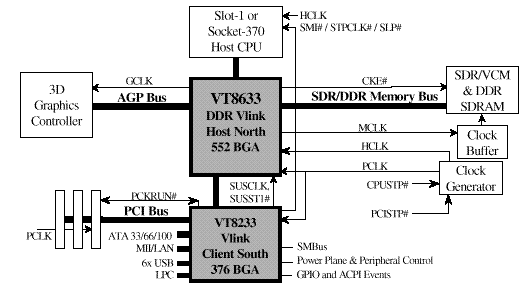
The chipset supports all current processors intended for Socket370/Slot1 and system bus frequency from 66 to 133 MHz what allows to install both the oldest PC66 DIMM, and the latest DDR2100 DIMMs. A combination with the old memory is possible in case of a processor with 66 MHz system bus. Possible memory size is up to 2 GBytes what is quite good considering a possibility of dual-processor configurations. As for the south bridge, here all the latest technologies were incarnated in silicon - HDD protocol support from PIO to ATA100, with data access fromHDD cache at 100 Mbps speed, 6 USB ports support (against 4 in old south bridges), 6-channel sound realized either with card inserted into ACR slot or with an integrated codec. BoardsWe tested 6 boards on this chipset:
AOpen AX37 Pro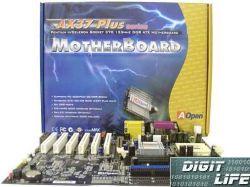 AOpen was first to offer boards of different colors and cover heatsinks with noble metals. Such heatsinks doesn't lose thermal conductivity characteristics for a long time. The company improved a design of board boxes. They are now packed in plastic cases and then in cardboard boxes. Our sample is a reproduction model, and it is of Pro version - without IDE-Raid controller. The complete set includes a user's manual in English, a poster with an installation manual and a list of switches, ATA66/100, ATA33, FDD cables and a bracket with 3 and 4 USB ports. A CD with drivers, Adobe Acrobat Reader and board descriptions in .pdf file, and a CD with Norton AntiVirus 2000. The board is black with a silvery heatsink. 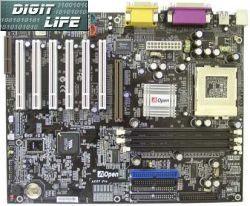 6 PCI -slots is a norm for today, and absence of ISA slot disappoints a bit. Position of a power supply slot doesn't completely corresponds to the ATX specs - the cable goes above the fan what prevents proper air circulation near the CPU. CD-in and AUX-in connectors can be covered with PCI cards. There are 10 LowESR 2200uF capacitors around the CPU. With switches you can set a base CPU frequency - Auto, 66, 100, 133 MHz, as well as to enable turning on a computer with a keyboard, and to enable a booting from the second Flash chip (Die-Hard BIOS). The only drawback is a lack of this chip on the board. BIOS is based on the AWARD v6.00PG, and it provides wide possibilities in system adjustment - FSB frequency can be changed from 66 to 248 (!) MHz in 1 MHz steps, memory frequencies are 66, 100, 133 MHz (asynchronous mode is supported). Vcore can be changed from 1.3V to 3.5V in 0.05V steps up to 2.05V and in 0.1V higher. However, it's dangerous for the CPU to lift the voltage more than by 20%. With increase of voltage up to 2.1V in BIOS Setup a real rated voltage becomes 1.7V. ASUS CUV266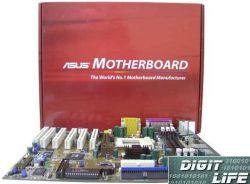 A number of boards produced in the last year by this company is more than 10 million samples. Every year the boards take leading places in reviews all around the world. The today's board is a pre-production sample. A standard red box includes a CD-R with a standard shell for installation of drivers and some utilities, FDD and HDD cables, a bracket with two additional USB ports.  DIMMs are located parallel to AGP, PCI and ACR slots. It makes it different from the previous ASUSTek products based on i850. Whether it is good or bad depends on your case. On the CUV266 the AGP Pro connector is mounted. Besides, the developers has installed 3Com network controller - 3C920, as well as C-Media chip - a normal audio chip with 4.1 audio system support. All other elements are situated conveniently (but for CD-in and AUX-in). The board features AFPANEL connector for ASUS iPanel. Unfortunately, this panel often causes the system to fail. ASUS has integrated a chip for monitoring fan rotation speed and temperatures (ASUS AS99127F). There are DIP-switches to change FSB frequency. There are also switches to change Vcore. The CUV266 can work in JumperFree mode. In this case you can change FSB frequency from 66 to 193 MHz in 1 MHz steps, Vcore can be changed from 1.7 to 2.0V in 0.05V. There are 9 1500 uF capacitors around the CPU. Unfortunately, there is no possibility to change voltage supplied to DDR SDRAM modules. BIOS Setup has a wide range of memory settings. Chaintech 6VJD The Chaintech 6VJD is an engineering sample. The complete set includes drivers on a CD-R, FDD and HDD cables. There is no a user's manual. The board has ACR (Advanced Communication Riser) and CNR (Communication Network Riser) slots. Why there are two actually identical slots is unclear. A power supply connector is located between a CPU and AGP slots what is inconvenient. It's impossible to insert DIMMs with already inserted AGP video card. another drawback is that a CD-in connector is covered with PCI cards. There are 9 2200uF capacitors around the CPU. The PCB is a bit smaller in size than the competitors. 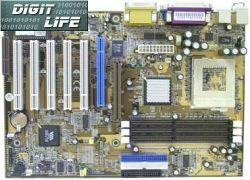 BIOS Chaintech 6VJD is standard and based on the AWARD 6.00PG. You can change memory latency and bank interleaving in memory settings. You can control SDRAM frequency - FSB, FSB+33 and FSB-33. CPU frequency can be changed from 66 to 170 MHz in 1 MHz steps. Vcore can be lifted by 0.3V in 0.05V steps. Unfortunately there is no possibility to control VIO and Vmem. Gigabyte 6RX We fetched the board in a technological package without a box, drivers, cables, a user's manual. The board features IDE-Raid controller based on a Promise chip which can be used as an additional ATA100 controller. IDE RAID and 4 DIMMs didn't make the board bigger in size. So, the board can be installed in any ATX case. The layout is well thought out, the only drawback is a position of Raid-controller connectors - they can be covered with a full-size PCI cards. The board has AGP Pro slot and an audio chip from Creative. There is a protection from BIOS failure - the second Flash EEPROM chip. There are two units of DIP-switches. The first allow to set Auto, 66, 100, 115, 124, 133, 140, 145 and 150 MHz FSB; the second in intended to change frequency from 1.55 to 1.8V in 0.05V steps. In order to increase stability of the system you can change VIO and Vmem. The rated chipset voltage is 2.5V and the chipset voltage is 3.3V. CPU frequency can also be changed from BIOS based on AMI 1.24a, there a frequency range is wider - 105, 110, 130 and 136 MHz in addition to the abovementioned. Memory setting are the same as in case of other boards - the frequency can be either equal to FSB or FSB +(-) 33 MHz. The BIOS is unfortunately lacking for Cyrix III support, that is why the processor failed to start on an old Samuel core. This support will be undoubtedly realized in the final BIOS version. Shuttle AV30 The model is again an engineering sample. The board is enclosed in a standard box which contains a user's manual in English, ATA66/100 and FDD cable, a CD with drivers. 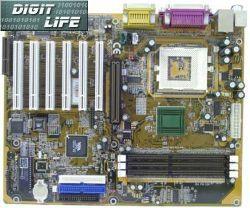 The PCB is implemented very competently, though there are some downsides. It's inconvenient ot install full-size board in the first three PCI slots since there are IDE and FDD connectors behind them. There is a clamp on an AGP slot thus preventing the card to fall out. CD-in, TAD and AUX-in connectors are located between an AGP slot and CPU socket what is very convenient. DIMMs are situated far enough from a video card. 9 LowESR 2700 uF capacitors are around the CPU. That is why you can mount a cooler with a huge heatsink. The board features a jumper for you to set Auto, 66, 100, 118 and 133 MHz of FSB. There is possibility to adjust Vmem - 2.5V (rated), 2.55V, 2.6V, 2.7V. In BIOS Setup you can change FSB frequency in 1 MHz step - at 66 MHz rated value: 66 to 99 MHz, at 100 and 118: from 100 to 132 MHz, at 133: from 133 to 166 MHz. Vcore can be changed in 0.05V step by 0.2V above the rated value and by 0.15V below the rated value. You can also change memory frequency: at 66 and 100 MHz you can set HostClk+33, and at 133 MHz you can set HostClk-33. Also, one can manually change memory latency as well as to set a required parameter of bank interleaving - 2, 4 or Disable. SuperMicro 370DDI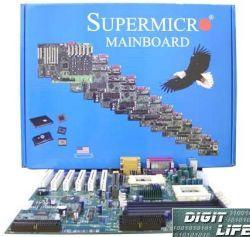 It is the only dualprocessor solution based on the Apollo Pro266 in our review. That is why we shouldn't compare it with other boards, but since there are no other boards with similar possibilities we have decided to include it in this review. The board is packed in a traditional box which contains a user's manual, ATA66/100 and FDD cables. Besides, there are two high quality AVC coolers. Plus, you can find there an IDE-Raid controller on a Promise PDC20267 chip with support of Raid 0, 1, 0+1 modes and AGP Pro slot. Everything is easy to reach. And it is no surprise considering its dimensions - the 370DDI won't suit every case. Huge heatsinks can be mounted easily, for example Sanyo which comes with PIII or GlobalWin. 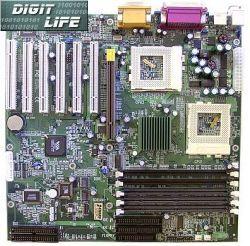 There are several usual switches and one intended for choosing DDR or usual SDRAM memory type. BIOS is AWARD 6.00. Besides, there is a possibility to change FSB frequency, though the clock speed can be altered only according to the table - 66, 75, 85, 90, 100, 110, 115, 124, 130, 133, 140, 150, 166, 180 and 200 MHz. You can also change memory latency and set bank interleaving. Such functions as change of Vcore or Vmem are absent since the board is intended for another market field where it finds no use. That is all I wanted to say about the boards. The only common downside of all of them is absence of ISA slots. Now let's dive into testing of the boards. PerformanceThe following equipment was used for testing:
Software:
Now we decided to use Windows 2000. Whereas the results in 3D applications do not differ from those obtained with Windows Millenium Edition, the results in business applications are much more better. Apparently it caused by the NTFS. A new test 3DMark 2001 was described in details, and here I only want to note that it is a synthetical test for system performance.  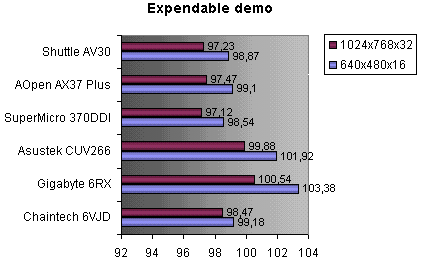 In the first test - a game one (Quake III - OpenGL and Rage Expendable - Direct3D) the board are divided into two groups. The first one (Gigabyte 6RX, ASUS CUV266 and Chaintech 6VJD) showed the best performance, and the second (AOpen AX37 Pro, Shuttle AV30 and SuperMicro 370DDI) showed lower results. Why it is so is unclear, maybe it's connected with BIOS. Note that everything can change yet - in production samples. Now let's check results of the boards in test packets which are based on popular business applications and programs for creation of graphics and sound:  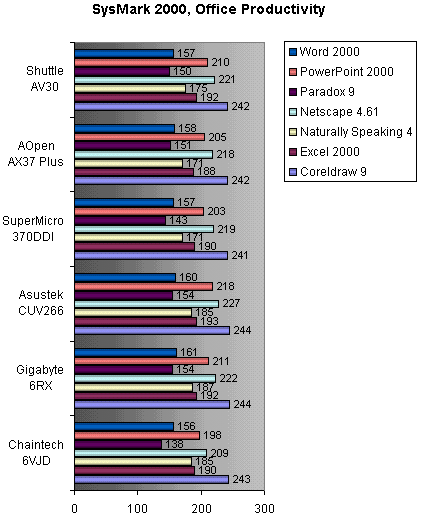 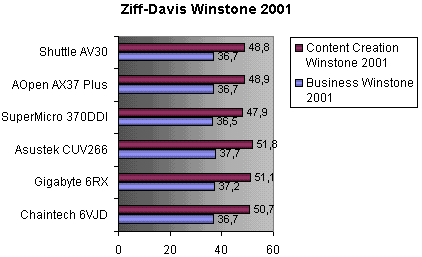 Here the differences are not so vivid but the first three boards of the previous test are again ahead. Now comes the professional 3D graphics. We tested the motherboards with a SPEC viewperf 6.1.2 packet.  The results are expected - the Gigabyte 6RX is again a leader. And the last comes the dessert - a new synthetical test from MadOnion - 3DMark 2001 which measures system speed by conducting different graphics tests.  Conclusion1. Gigabyte 6RXThe board turned to be a leader in our review - although it didn't take all the first places, it has still the largest number of functions. A perfect purchase, even with some tiny drawbacks. 2. Asustek CUV266It performed quite well in all tests of 3D graphics lagging behind only the Gigabyte. In business applications it managed to grab the first position, though. Undoubtedly, the CUV266 will find its user. 3. Chaintech 6VJDIts place is in the middle of the table. The board has neither the highest speed nor a huge set of functions. It will perfectly suit an unpretentious user who wants a board without unnecessary luxuries. 4. AOpen AX37 ProIt has a bright pleasant appearance together with quite good speed characteristics. Such boards are still exotic today. The AOpen AX37 Pro is intended for original people who want to stand out a crowd. 5. Shuttle AV30A real working horse: a small set of functions, lack of bright features, quite moderate speed results. But it suits perfectly a computer which is not designed for problems of high complexity. 6. SuperMicro 370DDISince the board differs from others we shouldn't compare it with them. Nevertheless, breakaway from the competitors is minimal even in these conditions. The product is intended for another market segment - it will be used as a base for entry-level servers and powerful work stations. And in this sphere stability matters much more than speed. In conclusion I should once more notice that the
results can change with release of production samples and new versions
of BIOS. As for the memory and the chipset, the market seems to
be perspective for them. It's no doubt that in the nearest future
SDRAM memory will be replaced by two faster types - DRDRAM and DDR
SDRAM.
Write a comment below. No registration needed!
|
Platform · Video · Multimedia · Mobile · Other || About us & Privacy policy · Twitter · Facebook Copyright © Byrds Research & Publishing, Ltd., 1997–2011. All rights reserved. | ||||||||||||||||||||||||||||||||||||||||||||||||||||||||||||||||||||||||||||||||||||||||||||||||||||||||||||||||||||||||||||||||||||||||||||